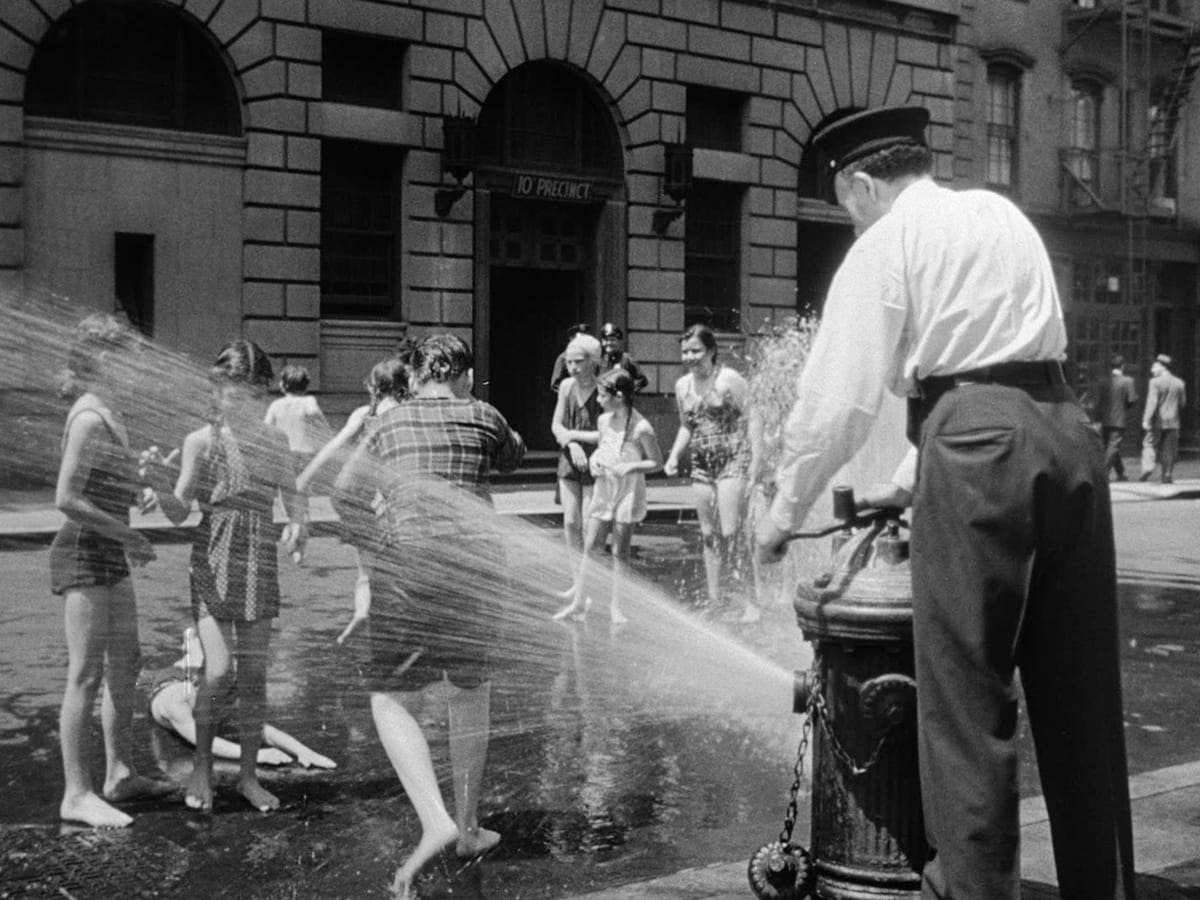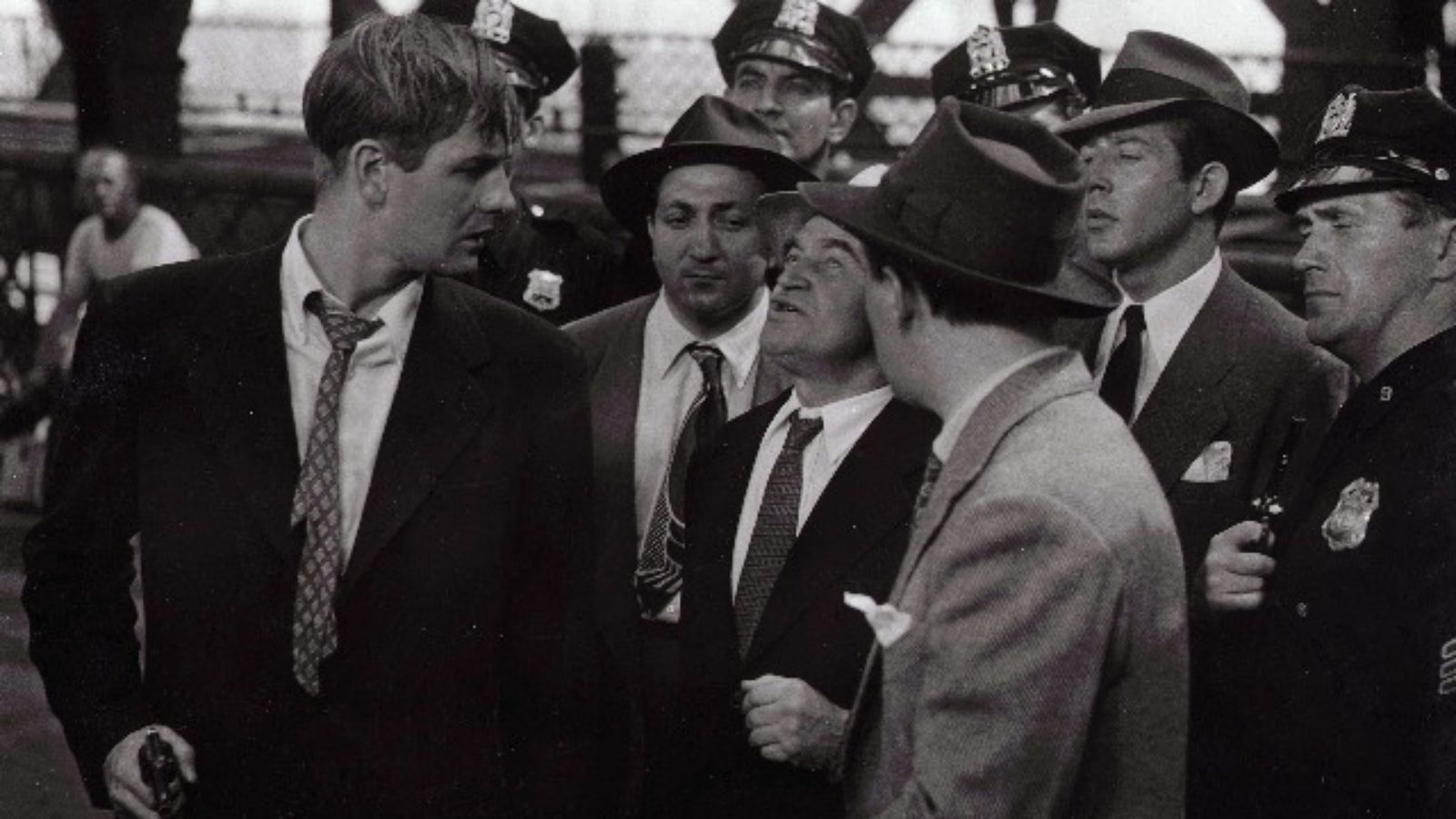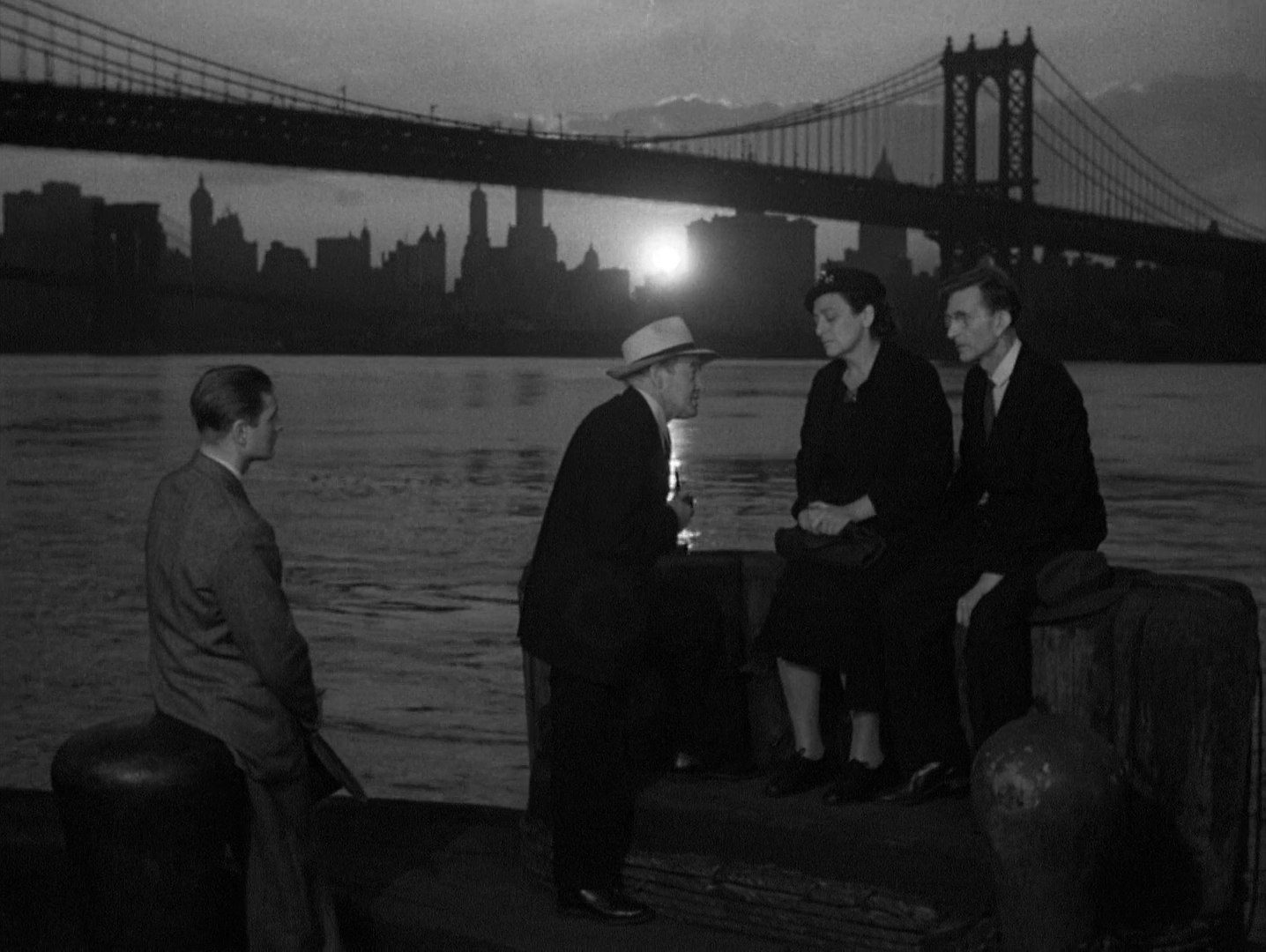The Naked City is often cited as a film noir, but as NYU film professor rightly points out, “This film opens where film noir ends. ” The Naked City is a 1948 movie that is less a noir and more a new emerging genre known as the police procedural, known today as copganda.
It was also directed by Jules Dassin, a lifelong communist who would be blacklisted shortly after the film’s release and left the US for France and later Greece; the film’s co-writer Albert Maltz was among the infamous Hollywood 10. However, the legacy of The Naked City is more than simply the genre it spawned. It is a revolutionary movie by a major studio that shows post-war New York City, warts and all, and gives the mythic city a life previously only found on sound stages in California.

Co-writer Malvin Ward got the title from a book of photos by famed New York photographer Weegee of New York crime scenes. A name given to him by the NYPD because he always seemed to arrive at the crime scenes before the press. “What do you got? A Ouija board?” But more than anything, Wald had wanted to make a movie that showed that just one individual didn’t solve crime.
Instead, Ward wanted to show that it took a team of hard-working beat cops, detectives, forensic experts, and others to solve a crime. In addition, the structure of The Naked City is a sprawling cast of characters, from different parts of New York, all while trying to find who murdered Jane Dexter, an ex-model.
Wald based his story on the real-life murder of the model Dot King. That murder was never solved, but according to Wald, he believed the investigation was closed down because the murderer was someone with power. Ironic, then, that in The Naked City, the cops not only solve the crime but that the murderer is from the slums of the Lower East Side.
But as much as Wald is the genesis of The Naked City, with Maltz brought in to add dialogue and a little more polish, the fascinating aspect isn’t the copganda; it’s how Dassin and producer Mark Hellinger caught New York City in all it’s raw, grimy, and vibrant glory. Filmed in over a hundred different locations, The Naked City ushered in a new era of films attempting to capture the genuine rhymes of modern life and harnessing a newly forged verisimilitude.
Inspired by the post-war Italian Neo-Realist movement, Dassain and cinematographer William H. Daniels worked together to push the medium into a new and exciting epoch. Location shooting was hardly recent, but no major Hollywood film had ever shot so extensively on location as The Naked City. Dassain and Daniels were given unprecedented access to locations thanks to Hellinger’s relationship with then-mayor Bill O’Dwyer.
Ranging from inside an actual morgue to one of the first looks inside a real tenement on the Lower East Side, The Naked City attempts to show New York City in all its varying forms of existence, except Harlem. Daniels even captures the architecture of the time, such as the original Penn Station, both exteriors and interiors, capturing the city in a celluloid amber.
Television would come along in just a few short years. Television, like the internet, changed how people live their lives in big and small ways. In some ways, The Naked City captures a way of life, pre-television, the streets crowded with people, walking, playing, and the Hurdy Gurdy man. Interestingly, before working with Dassin, Daniels was screen icon Greta Garbo’s personal cameraman, ensuring she always looked glamorous and securing her place in the ether of Hollywood stars. Before that, Daniels worked with the master Eric Von Stroheim’s silent epic, Greed, a film also shot on multiple locations.

Inicdenetly, location shooting itself was not so unusual, as silent films took advantage of locations all the time. It was only with the advent of sound that soundstages overtook location shooting, ushering in a new ear of sound design. But Dassin and Daniels custom-rigged new lighting setups, allowing night shoots and location shoots to be lit without having to substitute day for night. They took advantage of new modern cameras being lighter, allowing them to shoot scenes in elevators, cramped hallways, and even atop towering skyscrapers under construction.
All the location stuff is so good that the stuff shot on soundstages, or the instances they used rear projection for interior driving sequences, is jarring. The offices of detectives Lt. Dan Muldoon (Barry Fitzgerald) and Detective Jimmy Halloran (Don Taylor) look absurdly fake. Yet, Daniels and Dassin attempt to overcome this by stripping the sets bare, highlighting how bureaucracy robs individuals of personalities. These scenes emphasize how alive Naked City feels when it turns away from the police department and looks outside, from Muldoon cooking breakfast in his apartment to Halloran saying goodbye to his wife and kids at their house in Queens.
Dassin had previously made Brute Force, also shot by Daniels, a cinematic indictment of the carceral system so raw and outraged it makes The Naked City feel strangely muted. But if you look beyond the procedural aspects, part of what makes The Naked City sing is how Dassin and Daniels capture the residents of New York City going about their daily lives.
The class consciousness of The Naked City was so bold that it made Universal uneasy. Lines tossed off by Fitzgerald about silk pajamas found in the murdered woman’s apartment, t“Real fancy. You don’t get these for 3.95,” seem tame by today’s standards but, according to Wald, made the studio execs nervous.
Whether it’s two Brooklyn women standing outside a couture boutique wishing they had money for the dress on display or giving us the inner monologues of people like the floor cleaner of Penn Station, Dassin, Maltz, and Walden strive to show us the internal and exterior lives of the people of the time. In addition, the narrator is Hellinger himself,
Hellinger’s narration is one of my favorite things about The Naked City. On the one hand, it’s part and parcel of how so many noirs have a cynical narrator, but with Hellinger, we get a touch of the wise ass. He gives characters a hard time, “What’s the matter, Halloran? Lose him?” At the same time, he attempts to assuage the fears of random people, such as the woman anxiously reading the paper about Jane Dexter’s murder. “Don’t worry, lady, this doesn’t happen to stenographers.”
All the while, Hellinger gives us backstories, trivia, and comments from the peanut gallery as Dassin provides us with a snapshot of post-war New York City. We learn that Halloran fought in World War II through Hellinger’s voice-over. Hellinger’s voice enhances and colors the characters, making them richer and lived in.
The Naked City has been so often imitated and copied that it’s hard to see it for the breathtaking cinematic masterpiece it is. Fitzgerald’s gruff but twinkly-eyed Irish cop has oft been imitated but rarely equaled. Smoking his pipe as he looks out over the New York skyline, contemplating the case, Fitzgerald’s Muldoon is Wald’s answer to Sherlock Holmes.
Yet, despite its imitators, what sets The Naked City apart, aside from being the first, is how Dassin is striving to push the form into a new era, where real life and fiction converge and feed into each other. But he’s not sacrificing visual artistry to achieve it. It’s impossible to look at any frame of The Naked City without being moved by the poetic yet stark imagery. Dassin and Daniels capture real life and then add actors or take non-actors and put them into fake situations, finding truth in life and art.
The most soul-stirring scene might come from the scene where Lt. Muldoon and Det. Halloran talks to Jane Dexter’s parents, Mr. (Grover Burgess) and Paula Batory (Adelaide Kelin), on the docks, the sun setting behind the Brooklyn Bridge. The beauty of the image is made all the more melancholy by the Batory’s expression of grief and regret over Jane’s death.

The investigation, while the driving focus of The Naked City, is never allowed to overtake the little stories unfolding around it. Yes, we watch as Lt. Muldoon and Det. Halloran’s growing suspicion of Frank Niles (Howard Duff), who may know Jane better than he claims to. Despite his fiance and New York socialite Ruth (Dorthy Hart) claims to the contrary.
Wald and Maltz’s script isn’t afraid to take time out to show little slices of life. One of the more interesting detours the film takes is following Det. Halloran comes home after work to be greeted by his young wife, played by Anne Sargent. After ogling his wife’s new bathing suit, the two discuss their son, who keeps crossing the street despite constant warnings about how dangerous it is.
The two get into a frank and sometimes hilarious conversation about whether spanking is abuse, but even more so, whose job is it to hit the child? Neither wants to do it and in a darkly humorous twist, each tries to claim it’s the other’s gender responsibility to get out of doing this thing that neither parent wants to do.
More than anything, part of what makes The Naked City so alive is its thriving and complex class consciousness. Dassin refuses to cauterize the edges and instead shows how the classes co-exist and how the higher you go, the more the walls are built to keep the others out. All of this becomes more stark as The Naked City draws to its thrilling conclusion on the Lower East Side, with the suspect, Willie Garza (Ted de Corsia), finally being discovered.
Dassin and Daniels take us inside Garza’s apartment and into the cramped stairwells and hallways as the epic chase scene explodes onto the screen. Edited by Paul Weatherwax, whose keen eye for rhythm has kept The Naked City flowing so effortlessly until this point, it evolves further into cinematic perfection.
The architect James Sanders once said, “…New York is devoted to movement as you could argue no other city in the world is.” Weatherwax’s editing, both with the chase scene and with The Naked City, showcases this sentiment, with the overflowing crowds in the El trains, the throngs of people jostling along the street, and finally onto the Williamsburg Bridge as Halloran and Garzah chase each other, framed by Daniels’s lens showing how tiny the two men are as New York City looms over them.
The final line of The Naked City is iconic; as the movie was soon adapted into a television show, the line was used in every episode. “There are eight million stories in the Naked City. This has been one of them.” The ending shows a street cleaner sweeping up a pile of rubbish, which has a paper with a headline about Jane Dexter’s murder, into the trashcan. The bustling city never sleeps and never mourns, constantly moving, Dexter’s murder forgotten by all but those involved.
Dassin and Wald may have, intentionally or not, invented a genre that the state would co-opt to churn out propaganda. However, it’s important to note that Dassin was assigned a policeman bodyguard to look after Dassin and oversee the production to ensure the department wasn’t being portrayed negatively. But what survives, while the granddaddy of all police procedurals, is a humanistic snapshot of New York City, flaws and all, but with such love and care that it supersedes everything that it spawned.
There may be 8 million stories in the naked city, but few are as timeless and as of the moment as The Naked City.
Images courtesy of Universal-International
Have strong thoughts about this piece you need to share? Or maybe there’s something else on your mind you’re wanting to talk about with fellow Fandomentals? Head on over to our Community server to join in the conversation!

